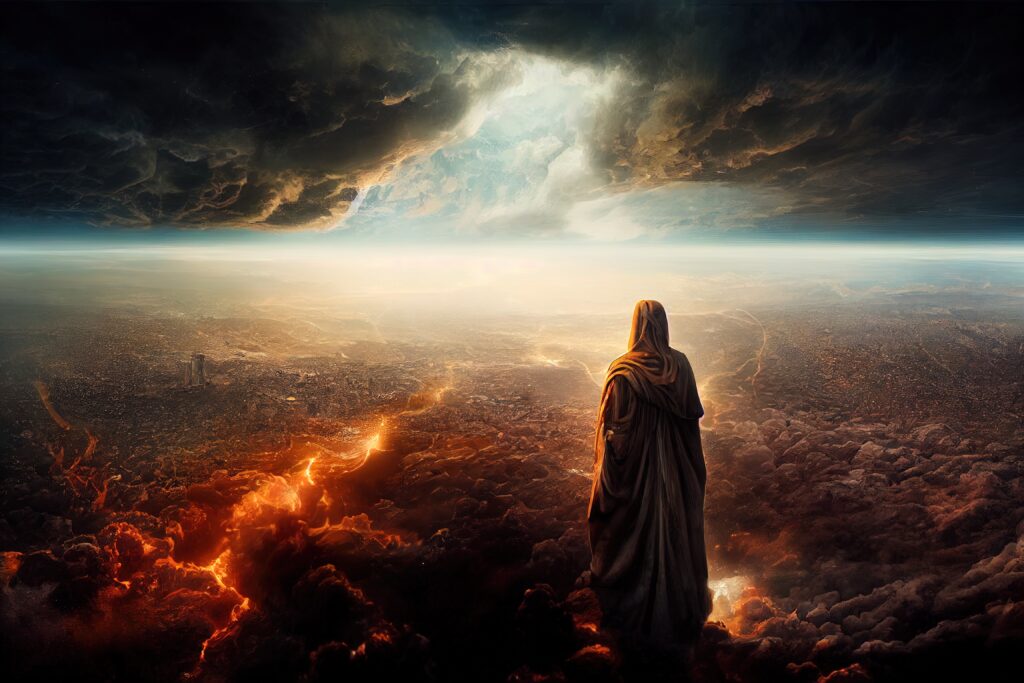
The Difference Between Visions and Their Explanations
And the people who belong to this world, whose names were not written in the Book of Life before the world was made, will be amazed at the reappearance of this beast who had died.“This calls for a mind with understanding: The seven heads of the beast represent the seven hills where the woman rules. They also represent seven kings.Five kings have already fallen, the sixth now reigns, and the seventh is yet to come, but his reign will be brief.“The scarlet beast that was, but is no longer, is the eighth king. He is like the other seven, and he, too, is headed for destruction. – Revelation 17:8-11.NLT
In apocalyptic prophecy, there is an important distinction between visions and explanations. In a vision, the prophet can travel anywhere in the universe and to any point of time. The events of the vision are not necessarily located in the prophet’s time and place. But when the vision is explained afterward, the explanation always comes in the time, place, and circumstances of the prophet. For example, in Daniel 2, Nebuchadnezzar is taken down to the end of time in his vision of the great image and the stone that became a great mountain that fills the whole earth (Dan. 2:31–36). The explanation of the vision by Daniel, however, is firmly grounded in the time and place of Nebuchadnezzar. It begins with a straightforward, unambiguous assertion, “You are this head of gold” (Dan. 2:38). Nebuchadnezzar is then told that the series of kingdoms that follow are “after you” (Dan. 2:39,) in point of time. As was the case with Daniel 2, the apocalyptic prophecy of Daniel 7 also is divided into two parts: the vision (Dan. 7:2–14, 21, 22) and explanations of the vision (Dan. 7:15–20, 23–27). Even though Daniel experienced all elements of the vision, including the final events, the explanation clarifies that the vision is essentially about the future experience of Daniel’s people (Dan. 7:17, 18, 23–27). The same pattern can be seen in Daniel 8 and Zechariah 4. Prophets don’t usually seem to understand a revelation from visions alone. An explanation is necessary for the revelation to be understood. Because that explanation is given for the benefit of the prophet, it is based on the time, place, and circumstances in which the seer lives. This principle has profound implications for the interpretation of apocalyptic texts, such as Revelation 17:7–11, as we will see.
The passage about the seven kings is not in the vision (Rev. 17:3–6); it is in the explanation of the vision (Rev. 17:7–18). So, the “one is” king or kingdom would have to be present at the time John himself received the vision in order for it to make sense. If the “one is” kingdom is the pagan Roman Empire of John’s day (that is, the sixth kingdom), then the five who are “fallen” are the superpowers of the Old Testament world: Egypt, Assyria, Babylon, Persia, and Greece. The seventh kingdom is the medieval Roman papacy, and the “eighth” kingdom (Rev. 17:11), which is from the seventh, would be the revived Roman papacy—the Babylon of Revelation 17, which includes the other two members of the satanic triad (the “dragon” of paganism/spiritualism and the “false prophet” of apostate Protestantism). This globalized form of Babylon riding the scarlet beast of secular political power is still in the future.
As we have seen, there are three worldwide alliances that develop in the end time: an alliance of the saints (God’s people) composed of an enlarged remnant church that includes those who have come out of Babylon to join them, an alliance of religious institutions, and an alliance of secular political powers. The last two alliances are precipitated by the final, worldwide proclamation of the gospel by the remnant (Rev. 14:6, 7; Rev. 18:1–4). Through the counterfeit gospel “inspired” by the demonic angels (Rev. 16:13, 14), Babylon (the satanic triad [Rev. 16:19]) gathers the secular/ political powers of the world to its side (Rev. 16:14, 16). She “rides” the beast (Rev. 17:2–7). For a short time, united institutions of religion dominate the world’s governments, turning their fury against God’s people (Rev. 17:6, 13:15–17). But the drying up of the Euphrates (Rev. 16:12) symbolically portrays the time when the secular/political powers that supported the harlot Babylon turn on her and destroy her (Rev. 17:16).
God saves His end-time people from destruction (Rev. 17:14). After the fall of Babylon, the secular powers of the world meet their end at the Second Coming (Rev. 19:17–21). Notice how every section we have studied, from the 7 churches, seals trumpets etc has ended with the second coming of Jesus. This is a clue as to how the information overlaps.
